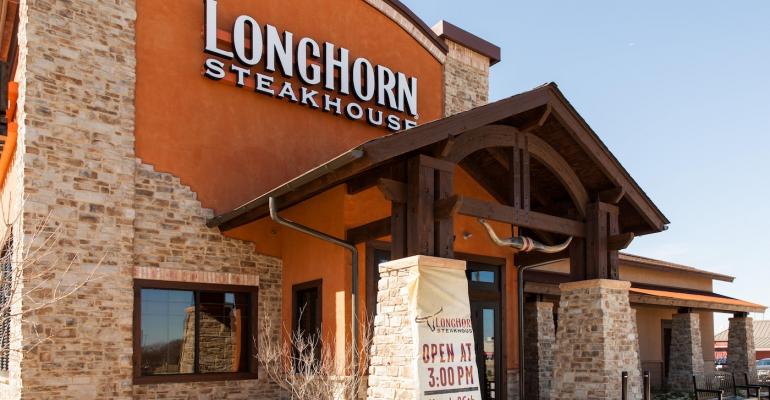Darden Restaurants Inc. on Thursday said it was offering $17 million in one-time bonuses to hourly workers and raising the pay floor for its non-tipped employees as restaurant companies beginning to add back workers let go in the COVID-19 pandemic.
Gene Lee, CEO and chairman of the Orlando, Fla.-based parent to Olive Garden, LongHorn Steakhouse and other brands, said Darden was making those investments to say thank you to workers and also to attract new workers.
“Part of why we're making this investment today is to say thank you and also to recruit,” Lee said in a third-quarter earnings call. “We know the teams with the best people will win in this environment. And we need to attract great people, offer them great opportunities, provide careers for them.”
Darden said it was offering one-time bonus, which totaled about $17 million for nearly 90,000 hourly team members, and committing, beginning Monday, that every hourly restaurant team member would earn at least $10 per hour, inclusive of tip income.
“This increase will impact 20% of our hourly team members, and we’re also committed to increasing the amount to $11 per hour in January 2022 and $12 per hour in January 2023,” a Darden spokesman said.
Lee said that “as we continue to grow our business and welcome guests back into our restaurants, continuing to attract and retain the best talent in the industry will be critical to our success.”
The CEO said that since the pandemic was declared in March 2020, Darden had invested more than $200 million in its teams through sick leave, COVID-19 emergency pay and “insurance payments and benefit deductions for team members who are furloughed.”
That investment also included the Darden policy to provide hourly restaurant team members up to four hours of paid time off for the purpose of receiving the COVID-19 vaccine, he said.
As of two weeks ago, Lee said in response to a question, Darden had about 115,000 hourly non-tipped employees compared to 165,000 before the COVID-19 restrictions.
“That number is increasing every week,” Lee said, “And I think our greatest challenge right now is staffing. It's staffing, trying to attract people to come to work. That's why we're strengthening our employment proposition, which is already strong. We've got to staff it. We've got to train people. We'll train people now in a very high-volume environment.”
In addition to keeping an eye on staffing, Darden continued to work on its digital offerings.
During the third quarter, nearly 19% of company’s sales were digital transactions, according to Rick Cardenas, Darden’s president and chief operating officer, and 50% of all guest checks were settled digitally, either online or on our tabletop tablets or via mobile pay.
“On the technology front, we are in the process of doing another three-year road map for technology,” Cardenas said. “We're going to continue to invest in technology to reduce friction in the guest experience and reduce friction on the team member experience.”
To ease operations, Cardenas said the Darden brands had streamlined menus and removed low preference or low-satisfaction items.
“This focus makes it easier for our restaurant teams to consistently execute our highest preference items, which means we are serving our most popular dishes to more guests,” he said. A year ago, the Top 10 entrées at Olive Garden accounted for about 48% of guest preference and today they account for about 55%, Cardenas said.
“We have dramatically reduced low-volume items, which reduces the need to prepare them, saving time and reducing food waste,” he said. “For example, at Longhorn Steakhouse, the number of total items with less than 1% preference is down to eight from more than 25 pre-COVID.”
By segment, third-quarter same-store sales, for the period ended Feb. 28, were down 25.8% at Olive Garden, down 12.6% at LongHorn Steakhouse, down 45.2% in the fine-dining division and down 36.9% for the other brands.
Darden said 99% of its units were open with at least some limited dining room capacity as of March 21. Using 2019 for its same-store comparisons in the weeks since Feb. 28, Darden said its blended same-store sales in the week ended March 21 were up 5.4% with Olive Garden up 5.7% in that two-year comparison and LongHorn up 23.2%.
To-go as a percentage of total sales were holding steady at 21% for LongHorn in the Feb. 28-March 21 period and slipping slightly — from 37% to 33% — at Olive Garden.
Lee said he expected Darden’s off-premise business to remain “robust when it's all said and done,” adding that he expected off-premise sales to fall off as restaurants expand indoor dining capacity. California, for example, remains at a 25% capacity limit.
“There's still a lot of people out there that are not fully vaccinated,” he added. “There's still good demand for the off-premise.”
For the third quarter ended Feb. 28, Darden’s net income fell to $128.7 million, or 98 cents a share, from $232.3 million, or $1.89 a share, in the same period last year. Sales fell 26.1% to $1.73 billion from $2.35 billion in the prior-year quarter.
As of Feb. 28, Darden had 1,822 restaurants, including 874 Olive Gardens, 528 LongHorn Steakhouses, 170 Cheddar’s Scratch Kitchens, 81 Yard Houses, 60 Capital Grilles (including two Capital Burger restaurants), 43 Seasons 52 units, 41 Bahama Breezes and 25 Eddie V’s restaurants.
Contact Ron Ruggless at [email protected]
Follow him on Twitter: @RonRuggless





